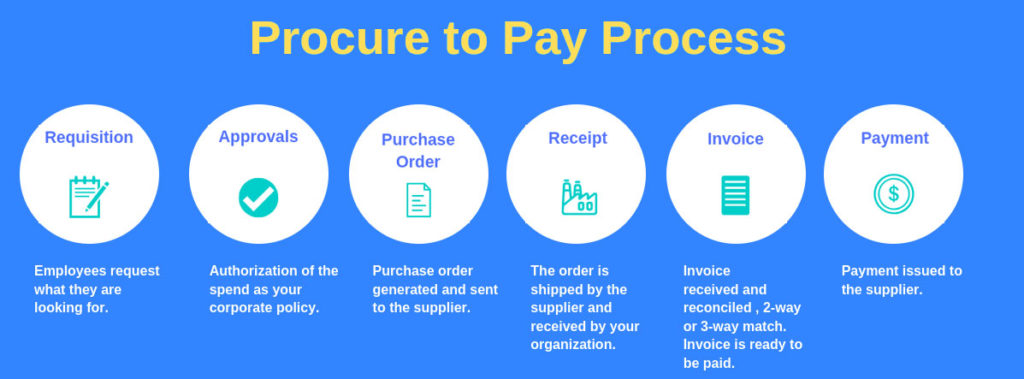In this article we are describing how to use Procure to Pay or P2P Process in Oracle NetSuite.
Procure to Pay is the process of how the organization manages its vendor-related processes. The process is similarly known by other names like purchase to pay or P2P. The P2P process includes the entire set of processes that involves sourcing, negotiating, requesting, ordering, receiving, and paying for purchases from your vendors. In simple words, it is the process that is designed to handle the complete procure-to-pay process.
Overview of Procure-to-pay in NetSuite
Procure-to-pay aims to offer better control and clarity over the whole transaction lifecycle. The process passes through various departments like purchase, production, accounting, etc. When you start manually accomplishing tasks within the P2P cycle, it can lead to issues like delayed or duplicate payments, payments made without internal approval, documentation errors, and some other inefficiencies. For this very reason, NetSuite helps to streamline and automate the manual steps of the P2P process.
Using 6 Key Features of Procure-to-Pay in NetSuite

Purchase requisition: A purchase requisition is a document that your employee will prepare a request to purchase the goods or services. It does not mean that you are purchasing anything while filling out the purchase requisition. Instead, you are only starting the process of purchase when you are asking about internal permission.
This document is prepared by an employee of your company when any need arises for some kind of goods or services. The manager or anyone who is in charge of purchases will get notified that an order request has been made by the employee after they receive the requisition.
Purchase requisitions is an internal document. Purchase requisitions provide the details that are required before finishing a purchase for approval such as
- Product Description
- Quantity
- Vendor name
- Price
- Name and department of purchaser
Purchase order: As the name suggests, the purchase order is defined by the details of the actual purchase. After the approval of the purchase requisition, the purchasing department will create and send the purchase order to the vendor. If the organization is not using purchase requisitions, then purchase department employees could fill the purchase orders for approval.

In contrast to a purchase requisition, the purchase order is an external document. Purchasing details are sent to the vendor as a set of instructions explaining how to fulfill your order and process your payment.
Once a purchase order gets final approval by the buyer and vendor, it becomes a legal document. POs contain every detail that the vendor needs to know to fulfill the order and your company’s requirements.
Item Receipt: The Item Receipt document contains detailed information like items, quantities, and arrival time of goods that were ordered by using a purchase order. The Item Receipt shows the status of the item whether it is received, not received, available, or frozen, and it provides the details about the received item in the warehouse.

Vendor or bill payment: Once the finance team receives the approved invoice from the vendor, they will process payments according to the contract terms. During the process, the purchasing company will require to check that payment details are updated and take steps to avoid the risk of accounts payable fraud.

Vendor return authorization: It is a non-posting transaction that follows up a return to a vendor that includes the items to be returned, their quantities, approval status, shipment status, and the refundable amount or credit from the vendor. This kind of transaction will be available when the Vendor Return Authorizations feature is enabled in NetSuite.


The vendor return process has four steps –
- Creating a vendor return authorization record
- Approving or canceling the authorization
- Shipping the items that are authorized to be returned
- Crediting an authorized vendor return
Vendor Credit: A vendor credit transaction creates a credit from a vendor, which could be applied to a payables account. For instance, a vendor credit transaction might occur when items are returned to a vendor or when a discount is negotiated with a vendor.

Learn more about Procure to Pay in NetSuite
The advantage of implementing Procure-to-pay in your business will let you have complete control over the purchasing process from PO entry and approval till receiving accounts payable. Therefore, every organization needs to use purchase requisition forms and PO forms because it will save their resources and time in getting work done. With NetSuite, businesses will be able to plan and manage their vendor processes effectively.
Contact our expert team of NetSuite Consultants to know more about Procure to Pay in NetSuite.

 “NS Success” is the NetSuite Consulting Practice of Dhruvsoft Services Private Limited – a leading NetSuite Solution Provider Partner from India – providing services worldwide …
“NS Success” is the NetSuite Consulting Practice of Dhruvsoft Services Private Limited – a leading NetSuite Solution Provider Partner from India – providing services worldwide …